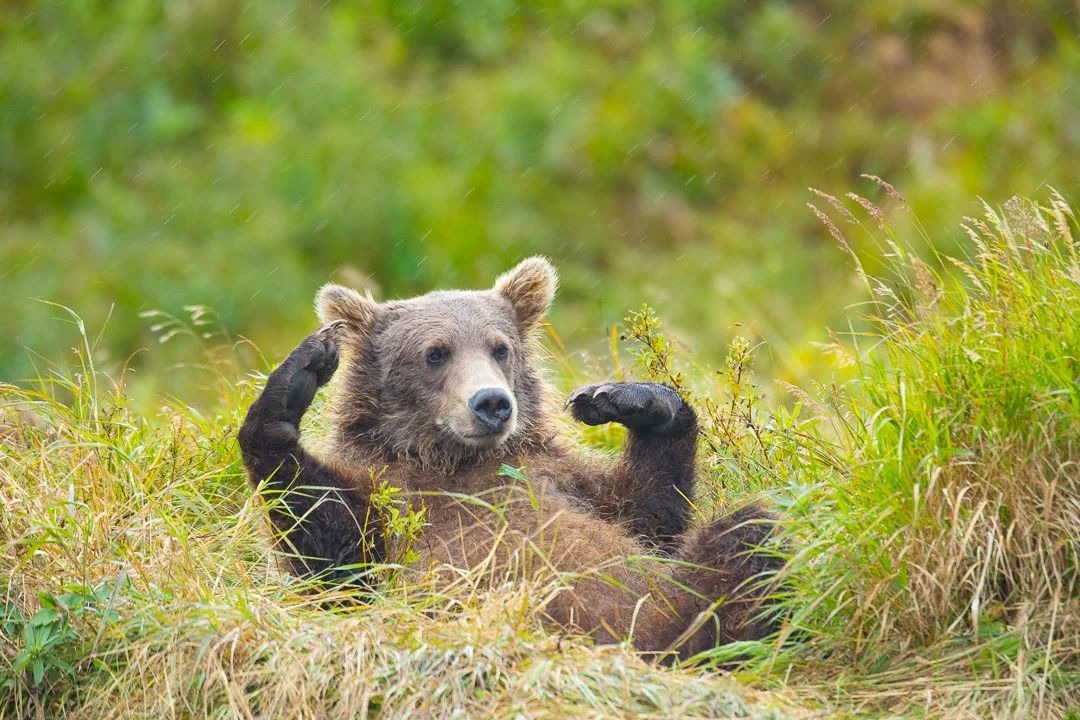The World of Grizzly Bears
There’s nothing quite like seeing your first grizzly bear. The sheer size, the power, and the presence of these animals leave a lasting impression. Watching one move through open tundra or stand in a rushing river reminds you that this is true wilderness, raw, unpredictable, and humbling.
Grizzly bears (Ursus arctos horribilis) are among the most awe-inspiring mammals in North America. With their powerful build, keen intelligence, and remarkable adaptability, they thrive in some of the continent’s wildest regions, from the tundra of Alaska to the mountains of Yellowstone, Grand Teton, and the Canadian Rockies.
A mother brown bear leads her cubs along an Alaska riverbank, searching for salmon.
Grizzly Bear in Yellowstone National Park.
Brown bear munching sedge grass in Alaska’s wilderness.
Grizzly vs. Brown Bears
Grizzly bears and brown bears are actually the same species (Ursus arctos), but they differ by region and habitat. Those that live inland, often in mountain valleys or forests, are called grizzlies, while the larger coastal bears, where salmon are abundant, are known as brown bears. Coastal bears tend to be heavier and more robust thanks to their high-protein diet, while inland grizzlies rely more on vegetation, roots, and smaller prey. Both share the same powerful build, keen sense of smell, and seasonal rhythms like hibernation and feeding during salmon runs.
Nine Fun Facts About Grizzly Bears
Powerful Build: Grizzlies are instantly recognizable by the muscular hump on their shoulders, which gives them incredible strength for digging and turning over logs or rocks in search of food.
Omnivorous Appetite: They eat both plants and animals, from berries, roots, and grasses to fish and carrion. Their diet changes with the seasons and availability of food.
Excellent Sense of Smell: A grizzly’s sense of smell is about seven times stronger than a bloodhound’s, allowing them to detect food or mates miles away.
Fast on Their Feet: Despite their size, grizzlies can sprint up to 35 miles per hour for short bursts, faster than a racehorse.
Solitary Wanderers: Grizzlies usually travel alone, except during mating season or when food sources, like salmon runs, draw several bears to the same area.
Protective Mothers: Female grizzlies are fiercely devoted to their cubs, caring for them for two to three years before they venture out on their own.
Winter Sleep: Grizzlies hibernate for up to seven months, surviving entirely on stored body fat. During this time, they don’t eat, drink, urinate, or defecate.
Keen Intelligence: They are known for problem-solving and memory, remembering food sources and human activity locations for years.
Wide Range: Grizzly bears once roamed much of western North America. Today, strong populations remain in Alaska, western Canada, and parts of the northwestern United States.
A brown bear catches a bright red sockeye salmon in Alaska’s wilderness, a defining scene of the summer season.
Where We See Grizzly Bears on Our Tours
We encounter grizzly bears in several of North America’s wildest landscapes. In Alaska, they’re often seen fishing for salmon along rivers or digging for clams in tidal flats. In Yellowstone and Grand Teton, grizzlies roam open meadows, valleys, and hillsides in search of roots, berries, and elk carcasses. We also photograph them in the Canadian Rockies, where they wander alpine slopes and dense forests. Each region offers a chance to capture their power and behavior in different environments, from feeding along rivers to foraging in mountain meadows.
Tips for Spotting and Photographing Grizzly Bears
Best times: Spring and summer, when coastal bears gather along rivers for salmon runs and inland bears are active in meadows and valleys after emerging from hibernation. In the fall, both move to areas rich in berries and other high-calorie foods as they prepare for hibernation.
Where to look: Riverbanks, meadows rich in vegetation, and hillsides with berry patches. In coastal areas, focus on salmon streams, tidal flats, and estuaries.
Photography tip: Use a long lens to maintain a safe distance and focus on natural behaviors such as feeding or interaction between mother and cubs.
Composition: Include elements of their surroundings, such as snow-capped peaks, wildflowers, or reflective water, to create a stronger sense of place.
Behavior cues: Watch for relaxed feeding or playful cubs as signs that the bears are comfortable. Raised heads or pacing can mean they are alert, so always give them extra space.
Grizzly bears are considered a conservation success story in many parts of North America, though their recovery remains uneven. Once pushed to the brink of extinction in the lower 48 states, populations have rebounded in protected areas like Yellowstone and Glacier National Parks thanks to decades of conservation efforts. In Alaska and Canada, grizzlies continue to thrive across vast wilderness regions. However, habitat loss, human-wildlife conflicts, and climate change still pose ongoing challenges for their long-term survival.


































